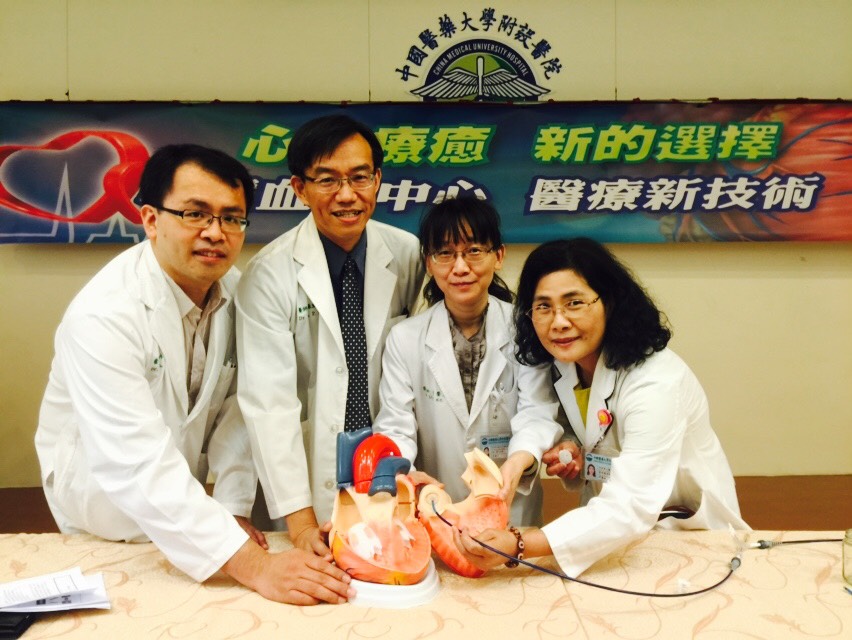News and Award
About CMUH
New Medical Technology Reimbursed by National Health Insurance: Left Atrial Appendage Occlusion (LAAO) effectively helps patients with atrial fibrillation in stroke prevention

Left Atrial Appendage Occlusion (LAAO) resolves threat from stroke for patients with atrial fibrillation
Atrial fibrillation (abbreviated as AF) is the most common type of cardiac arrhythmia, which is more likely to occur as one ages. In Taiwan, about 1% of people are estimated to suffer from AF. The occurrence of atrial fibrillation will likely form thrombosis when there is obstruction for blood circulation in atrium. According to statistics, the likelihood of patients with AF to suffer thrombosis is five times greater than that of normal people.
In this case, Mr. Lin is 60 years old and has suffered from high blood pressure and diabetes for years with heart failure. Ten years ago Mr. Lin received percutaneous coronary interventions (PCI) due to myocardial infarction. Mr. Lin also has years of medical history in paroxysmal AF. Three years ago Mr. Lin received thrombolytic injection at the emergency department due to acute cerebral infarction. Although the symptoms of strokes were alleviated, he also suffered from complications in hematencephalon. For this reason, Mr. Lin did not receive the treatment through taking oral anticoagulants after being discharged from the hospital but only takes Antiarrhythmic drugs and dual antiplatelet medications.
Last December, Mr. Lin again suffered from minor acute cerebral infarction. According to the “Atrial Fibrillation and Thromboembolism Risk Assessment,” Mr. Lin has scored 5 points and the likelihood of reoccurrence is quite high while it is inevitable for Mr. Lin to receive more effective treatment. After discussing with CMUH Cardiovascular Medicine Deputy Director Ping-Han Lo for the pros and cons of various strategies, Mr. Lin finally received the percutaneous coronary interventions. Under general anesthesia and the guidance of esophageal ultrasound sonography, the watchman device has been successfully implanted to occlude the opening of left appendage.

According to the score of “Atrial Fibrillation and Thromboembolism Risk Assessment,” patients having a score over 2 points should take lifelong anticoagulants for treatment to lower the risk of strokes. However there are many scruples from taking anticoagulants. For example, patients will experience prolong bleeding when injured and the interaction between food or other medications. Patients will also need to suspend the medication for a few days before receiving tooth extraction or other surgeries, in order to wait for the recovery of hemostatic function. Anticoagulants can also increase the risk of internal bleeding or hematencephalon. Hence only less than 50% of patients with AF accept proper anticoagulant medication. Deputy Director Ping-Han Lo indicates that: “Left Atrial Appendage Occlusion produces small wounds without the need to open up the chest; the success rate is high and can effectively lower the risk of stroke.”
For patients of nonvalvular atrial fibrillation, 90% of thrombosis is generated in the left atrial appendage. Hence occluding the opening of left atrial appendage can effectively lower the risk of such patients suffering from thromboembolism. After 15 years and multiple large clinical research evidence suggest that Left Atrial Appendage Occlusion can be planted safely. Nonetheless it is proved that Left Atrial Appendage Occlusion is the new choice in stroke prevention for AF patients. The American Food and Drug Administration also reviewed and passed the LAAO last year that it LAAO can be used to replace anticoagulants over the long run and can be applied as the treatment approach to prevent strokes in patients of nonvalvular atrial fibrillation.
China Medical University Hospital –Cardiovascular Medicine Deputy Director Ping-Han Lo



![[Taiwan–Malaysia Medical Innovation Forum] CMUH and UNIMAS Co-Host Major Medical Symposium to Advance Medical Technology and Precision Patient Care img](/FileUploads/News/20250714_131324.jpg?w=250&h=180&mode=crop&scale=both)